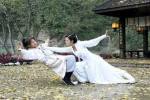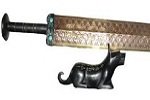Military Art by Sun Tzu: Laying Plans
Home ![]() Famous People From Ancient China
Famous People From Ancient China ![]() Sun Tzu
Sun Tzu ![]() Military Art: Laying Plans
Military Art: Laying Plans
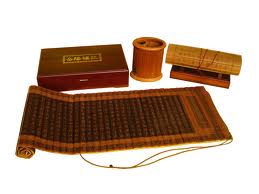
The Chinese military art book the Art of War is the oldest military treatise in the world. It was writen by Sun Tzu ( also known as Sun Zi or Sun Wu) and has been traslated into many languages.
Chapter one: Laying Plans
1. Sun Tzu said: The art of war is of vital importance to the State.
2. It is a matter of life and death, a road either to safety or to ruin. Hence it is a subject of inquiry which can on no account be neglected.
3. The art of war, then, is governed by five constant factors, to be taken into account in one's deliberations, when seeking to determine the conditions obtaining in the field.
4. These are: (1) The Moral Law; (2) Heaven; (3) Earth; (4) The Commander; (5) Method and discipline.
5,6. The Moral Law causes the people to be in complete accord with their ruler, so that they will follow him regardless of their lives, undismayed by any danger.
7. Heaven signifies night and day, cold and heat, times and seasons.
8. Earth comprises distances, great and small; danger and security; open ground and narrow passes; the chances of life and death.
9. The Commander stands for the virtues of wisdom, sincerely, benevolence, courage and strictness.
10. By method and discipline are to be understood the marshaling of the army in its proper subdivisions, the graduations of rank among the officers, the maintenance of roads by which supplies may reach the army, and the control of military expenditure.
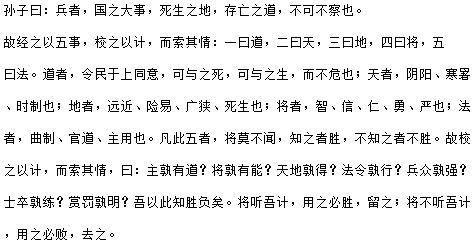 Chinese Military Art by Sun Tzu: Laying Plans text in Symlified Chinese, Part 1
Chinese Military Art by Sun Tzu: Laying Plans text in Symlified Chinese, Part 1
11. These five heads should be familiar to every general: he who knows them will be victorious; he who knows them not will fail.
12. Therefore, in your deliberations, when seeking to determine the military conditions, let them be made the basis of a comparison, in this wise:--
13. (1) Which of the two sovereigns is imbued with the Moral law? (2) Which of the two generals has most ability? (3) With whom lie the advantages derived from Heaven and Earth? (4) On which side is discipline most rigorously enforced? (5) Which army is stronger? (6) On which side are officers and men more highly trained? (7) In which army is there the greater constancy both in reward and punishment?
14. By means of these seven considerations I can forecast victory or defeat.
15. The general that hearkens to my counsel and acts upon it, will conquer: let such a one be retained in command! The general that hearkens not to my counsel nor acts upon it, will suffer defeat:--let such a one be dismissed!
16. While heading the profit of my counsel, avail yourself also of any helpful circumstances over and beyond the ordinary rules.
17. According as circumstances are favorable, one should modify one's plans.
18. All warfare is based on deception.
19. Hence, when able to attack, we must seem unable; when using our forces, we must seem inactive; when we are near, we must make the enemy believe we are far away; when far away, we must make him believe we are near.
20. Hold out baits to entice the enemy. Feign disorder, and crush him.
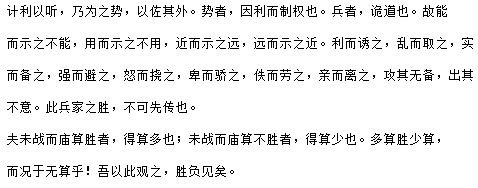 Chinese Military Art by Sun Tzu: Laying Plans text in Symlified Chinese, Part 2
Chinese Military Art by Sun Tzu: Laying Plans text in Symlified Chinese, Part 2
21. If he is secure at all points, be prepared for him. If he is in superior strength, evade him.
22. If your opponent is of choleric temper, seek to irritate him. Pretend to be weak, that he may grow arrogant.
23. If he is taking his ease, give him no rest. If his forces are united, separate them.
24. Attack him where he is unprepared, appear where you are not expected.
25. These military devices, leading to victory, must not be divulged beforehand.
26. Now the general who wins a battle makes many calculations in his temple ere the battle is fought. The general who loses a battle makes but few calculations beforehand. Thus do many calculations lead to victory, and few calculations to defeat: how much more no calculation at all! It is by attention to this point that I can foresee who is likely to win or lose.
Other Chapters of the Art of War by Sun Tzu:
- Laying Plans
- Waging War
- Attack by Stratagem
- Tactical Dipositions
- Energy
- Weak Points and Strong
- Maneuvering
- Variation in Tactics
- The Army on the March
- Terrain
- The Nine Situations
- The Attack by Fire
- The Use of Spies
* The version was translated by Lionel Giles in 1910.
Related Readings:
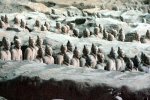
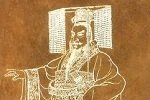

Home ![]() Famous People From Ancient China
Famous People From Ancient China ![]() Sun Tzu
Sun Tzu ![]() Military Art: Laying Plans
Military Art: Laying Plans

New York Pass With More than 50 Sttractions

Southern California CityPASS saves you 32% for Disneyland, Universal Studios and 3 other attractions

